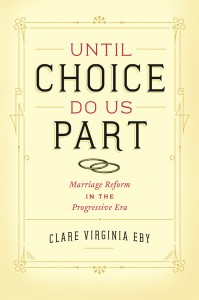Donna J.Drucker is a guest professor at the Technische Universität Darmstadt, Germany. She is the author of The Classification of Sex: Alfred Kinsey and the Organization of Knowledge (Pittsburgh, 2014) and The Machines of Sex Research: Technology and the Politics of Identity, 1945–1985 (Springer, 2014).
Clare Virginia Eby. Until Choice Do Us Part: Marriage Reform in the Progressive Era. Chicago: University of Chicago Press, 2014. Pp. xx + 237.
With Until Choice Do Us Part, Clare Virginia Eby has made a rich and engaging contribution to scholarship on the history and literature of the American Progressive Era. Eby has three principal goals: to outline the ideas of the major theorists of marriage reform, highlighting their similarities and differences; to investigate how three heterosexual married couples attempted to live out marriage reform ideals; and to argue for the importance of those theorists and practitioners in “the wide diffusion and acceptance of modern ideas about marriage and sexuality” (9). Although the longer-term impact of the marriage reformers and practitioners through the present is not always obvious, Eby articulates strong relationships between the marriage theorists, the actions of married couples who engaged those ideas in their own relationships, and the fictional and nonfictional texts that those spouses produced. Oftentimes, the theorists and the couples knew each other in real life, intertwining emotion, writing, and belief in intimate ways.
The first chapter provides a broad overview of the history of traditional heterosexual marriage in the United States, with attention to some of the communities of the nineteenth century that promoted alternatives to it, such as New Harmony, Oneida, and Mormonism. Marriage, Eby argues, drew intellectual attention to a central question of American democracy: the relationship of individual citizens and to the common good. While much scholarship on the Progressive Era focuses on reformers’ attempts to promote broad social change, the marriage reformers focused their attention on shaping the ideas and practices of married individuals, believing that “they lived in a transformational era in which each spouse could claim a right to happiness—and in doing so promote the broader social good” (34). Given the significant legal differences in the status of men and women, which had just begun to narrow at the end of the nineteenth century, new articulations of the legal and socio-cultural meaning of marriage and being a husband or wife were ripe for intellectual theorization.
 The second chapter outlines the development of that theorization from the 1880s through the early 1920s, focusing on the most prominent English-language writers from the U.S. and around the world: George Elliott Howard, Elsie Clews Parsons, Ellen Key, Havelock Ellis, Edith Ellis, Olive Schreiner, Charlotte Perkins Gilman, Thorstein Veblen, and Edward Carpenter. Schreiner, Gilman, and Veblen identified economic inequality between husbands and wives as a source of power differentials and a weakness in the institution of marriage. Each of them called for a new valuation of women’s labor inside the home and opportunities for work outside the home. Howard, Ellis, Key, Carpenter, and Parsons all argued for the importance of pre-marital sexual experimentation in some form, and that marriage and the decision to marry should adhere to “inner laws” instead of religious or state laws (Carpenter, 50). The Ellises, Key, and Carpenter advocated voluntary monogamy, in which a couple affirmed the strength of their union by the freedom that they allotted themselves and each other to seek temporary affairs. Carpenter and Parsons promoted the idea that voluntary monogamy would reduce the number of divorces. Havelock Ellis and Key also wished to improve sexual behavior within marriage by educating husbands in technique and centering erotic pleasure as a fundamental element of successful marriages. However, Eby points out that the theorists’ beliefs in dualistic, biologically based gender difference and eugenics weakened those other seemingly forward-thinking positions.
The second chapter outlines the development of that theorization from the 1880s through the early 1920s, focusing on the most prominent English-language writers from the U.S. and around the world: George Elliott Howard, Elsie Clews Parsons, Ellen Key, Havelock Ellis, Edith Ellis, Olive Schreiner, Charlotte Perkins Gilman, Thorstein Veblen, and Edward Carpenter. Schreiner, Gilman, and Veblen identified economic inequality between husbands and wives as a source of power differentials and a weakness in the institution of marriage. Each of them called for a new valuation of women’s labor inside the home and opportunities for work outside the home. Howard, Ellis, Key, Carpenter, and Parsons all argued for the importance of pre-marital sexual experimentation in some form, and that marriage and the decision to marry should adhere to “inner laws” instead of religious or state laws (Carpenter, 50). The Ellises, Key, and Carpenter advocated voluntary monogamy, in which a couple affirmed the strength of their union by the freedom that they allotted themselves and each other to seek temporary affairs. Carpenter and Parsons promoted the idea that voluntary monogamy would reduce the number of divorces. Havelock Ellis and Key also wished to improve sexual behavior within marriage by educating husbands in technique and centering erotic pleasure as a fundamental element of successful marriages. However, Eby points out that the theorists’ beliefs in dualistic, biologically based gender difference and eugenics weakened those other seemingly forward-thinking positions.
The last three chapters examine how three prominent Progressive Era couples put the ideas of modern marriage into practice. Eby chose those couples wisely, as each member of the couple, and often their colleagues and friends, had written letters, plays, novels, and/or articles about marriage. Writing about one’s marriage was a means of clarifying emotions and beliefs, and a concrete way of generally publicizing one’s actions. Not all of the writings were equally available to the voracious reading public —particularly the letters and one unfinished novel—so how much the writings affected public thought beyond the authors’ immediate circle is unknown. Nonetheless, Eby demonstrates the varying degrees to which these couples internalized the ideas of husband-hood, wife-hood, commitment, and voluntary monogamy that compromised marriage reform ideals.
Eby focuses on Upton Sinclair and Meta Fuller Sinclair, Theodore Dreiser and Sara White Dreiser, and Neith Boyce and Hutchins Hapgood. The marriage of the Sinclairs fell apart due to incompatibilities regarding sex, emotion, and creativity. Upton Sinclair’s novel Love’s Pilgrimage (1911) and Meta Fuller Sinclair’s unpublished manuscript “Corydon and Thrysis” (n.d., c. 1910–11), along with their dueling accounts of non-monogamy in the newspapers “illustrates how the Progressive era campaign to reform marriage was a battle of the books” (103). The two versions of Theodore Dreiser’s novel, The Genius (1911) and The “Genius” (1915), show Dreiser’s progression from the marriage theorists’ version of non-monogamy to a more Greenwich Village, Bohemian position of open marriage. Sara White Dreiser left only a few, probably posthumously censored letters, but her disappointment regarding the marriage that deteriorated throughout the 1910s is nonetheless obvious. Boyce and Hapgood wrote separately and together about how their practice of non-monogamy shaped their decades-long marriage, and co-acted in their own play (Enemies, 1916). Their “ardent desire to reform marriage, combined with an equally ardent commitment to preserving it, exemplifies what this book identifies as central to Progressivism” (169).
Only a few weaknesses exist in an otherwise well-argued and convincing book. Brief discussions of Progressive Era parallels to the sex columnist Dan Savage and to present-day developments are unnecessary and take attention away from Eby’s primary historical arguments. In addition, some consideration of the role of whiteness and social class in developing the intellectual vision and everyday practice of marriage would have enriched the study. Lastly, the conclusion failed to explain why Progressive Era marital thought fell out of favor for much of the remaining twentieth century, though interest in its themes has revived in the twenty-first century.
This book would work well in graduate history or English courses focusing on autobiography, the Progressive Era, the history of marriage, or the history of gender and sexuality. It provides a model for effectively mining historical and literary sources together to support an argument. The summarizing chapter on Progressive thought on marriage, would pair well with primary source selections and introduce students to the diversity of thinking on the subject. Ideally, Until Choice Do Us Part will inspire further research that so clearly connects ideas, practices, and life stories of American intellectuals.


0